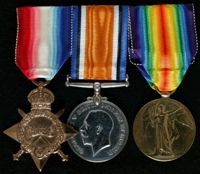

(L to R) 1914-15 Star; British War Medal; Allied Victory Medal
Frederick, or Fred as he was known, was born between April and June 1897 in Openshaw, Manchester. His father was called Edmund and his mother was Esther. He had an older sister called Esther Lavina and 4 younger siblings that we know of: Louisa Elizabeth, Thomas, Arthur and Rose. Fred was named after Edmund's brother.
In 1901 the family lived at 36 Gibbon Street in Bradford, Manchester. Edmund worked as a general labourer. This was still his job in 1911. In this year he was employed at a Corporation Gas Works, run by the contemporary equivalent of a City Council. We don't know if he had also worked here in 1901.
The family now lived at 50 Hassop Street off Ashton New Road in Beswick, Manchester. Edmund's brother Frederick had the same job at the same place. He was staying with Edmund and his family when the 1911 Census was taken in April, although we don't know whether this was a permanent arrangement. Esther Lavina had moved away from home, she was a domestic servant for Reverend Frank Merryweather and his family at their home, 9 Garden Street in Todmorden, West Yorkshire.
We don't know what work Fred did after he left school. At some point between September 1913 and February 1914 he decided to become a Special Reservist in the Army, and joined the 4th Battalion of the Manchester Regiment. He was given the service number 1962.
A Special Reservist was a man who had not previously served in the Regular Army. They kept their civilian home and job, but trained to be a soldier for a short period every year. Unlike the Territorial Force, which was intended to serve as complete units within the UK or Empire, Special Reservists could be sent to join Army units anywhere as individuals or in small groups.
Fred's initial training was full-time and lasted for 6 months. Afterwards he was released to return home. The 4th Battalion's 1914 training appears to have taken place in Wales. It will have taken place during the summer and probably lasted around 3 weeks. Fred sent his mother a postcard during the training. At the time she lived at 164 Husband Street in Miles Platting, Manchester. Unfortunately the postmark is illegible, so we don't know exactly when the card was sent. It read:
Dear Mother,
I am not out yet will you [2 words crossed out] send me some cigarettes and will you ask him to send me some. I will have 12/- [12 shillings] to come when I come out so I hope it will not be long.
From Fred
The postcard showed a group of nine Manchester Regiment soldiers in front of their tents. Two of them are Corporals, but unfortunately we don't know which of the other seven Fred was.
The First World War broke out on the 4th August 1914 and members of the Special Reserve were called into service within a few days of this. The 4th Battalion left its Headquarters in Ashton-under-Lyne and moved to the Humber estuary. This allowed it to be used to defend against a German invasion as well as carrying out training. It moved to Riby, Lincolnshire during October.
The 4th Battalion was not a front line unit. Its role was to train Special Reservists who would then be sent to a Regular battalion of the Manchester Regiment as reinforcements or to replace casualties. Fred was sent to France on the 12th January 1915 and joined the 1st Battalion of the Manchester Regiment in the Bethune area. They had taken heavy casualties since arriving in France in late September 1914.
We don't know much about what Fred did in France. The only large scale battle he took part in was Neuve Chapelle between the 10th and 13th March 1915. The 1st Battalion attacked to the South East of the village on the 11th, but were unsuccessful. The next day they attacked towards the Bois de Biez. They reached the German trenches but suffered heavy casualties. Other units taking part in the attack were not so successful, so the battalion had to withdraw to avoid being cut off.
At some point during this period Fred was wounded. He was evacuated to a hospital in Boulogne, on the Channel coast, but his wounds were too severe and he died on the 21st March 1915. He was just 17 years old. We don't know for certain when he was wounded.
Fred was buried in Boulogne Eastern Cemetery along with 5731 other men. His grave reference is III. D. 43.
Fred's medals were donated to the Museum of the Manchester Regiment in October 2002.




